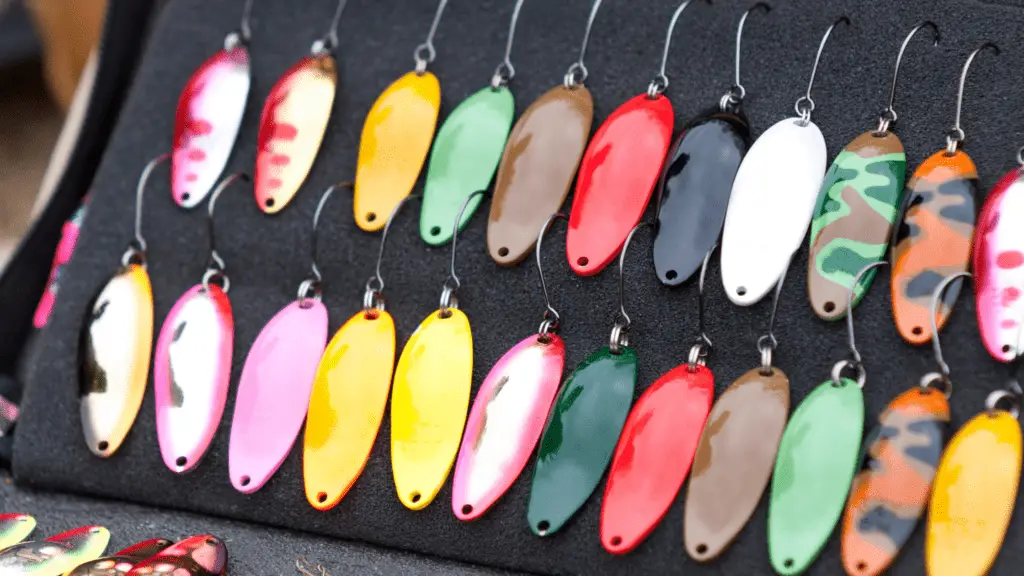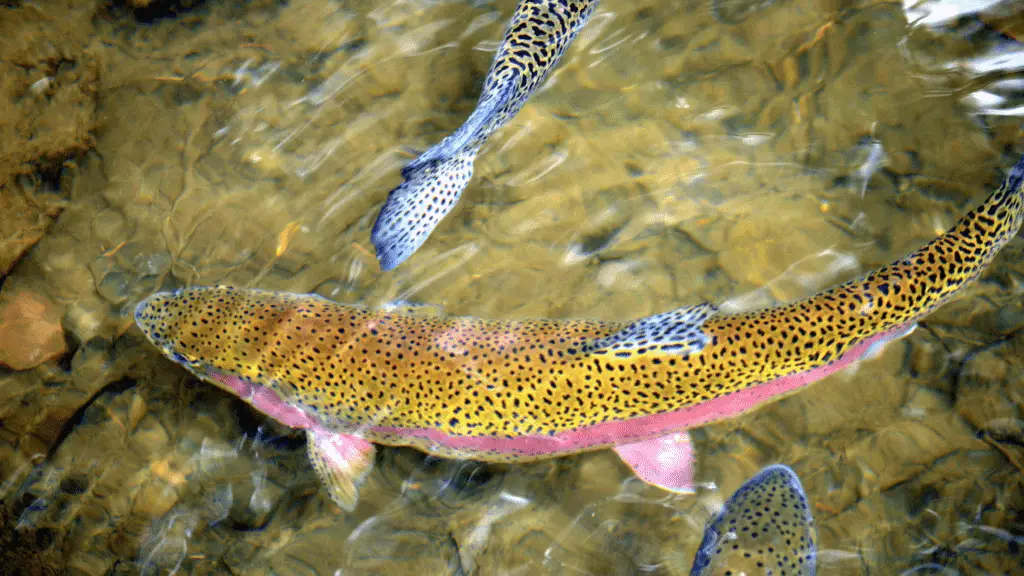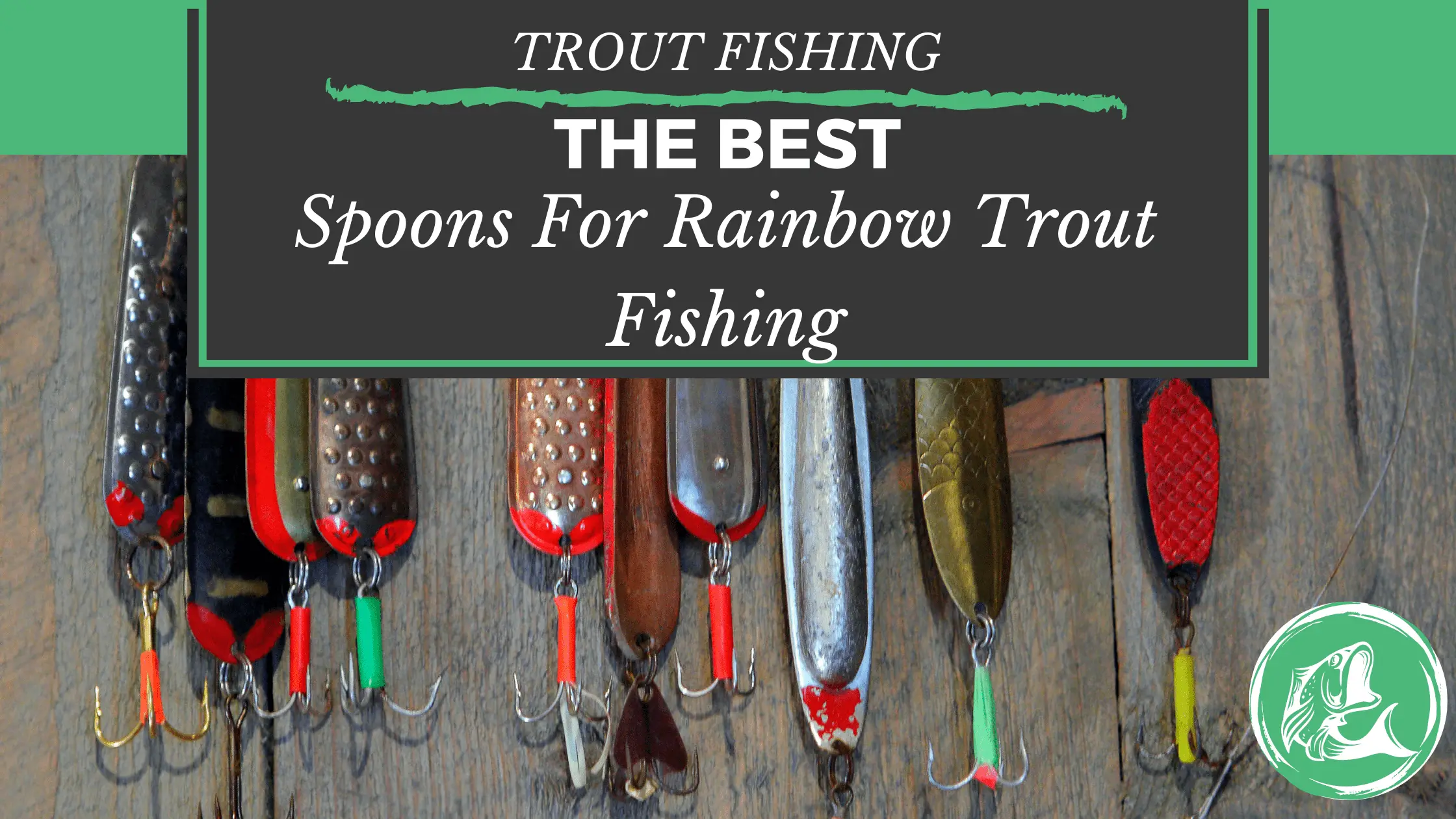Artificial lures are designed to entice freshwater Rainbow Trout to take the bait by copying their natural hunting instincts. If you want to have a good catch, look at the list for the Best Spoons for Rainbow Trout. Furthermore, popular hooks blend in well with their surroundings and mimic the fishes’ usual food source.
Rainbow Trout preys on other fish. These sea creatures eat anything they can get their jaws on. Moreover, they eat small water worms, tiny crustaceans, fish larvae, and young fishes. They supplement their diet with plankton and smaller fishes during their growth. Also, the diet of juvenile and adult Rainbow Trout consists primarily of large crustaceans, insects, and fishes.
In comparison to other trout species, they often eat more insects and attack from the surface. Keep in mind that hatchery fish are raised on sinking small pellet food, which affects their normal feeding habits. It is important to understand their feeding preferences to choose the right spoon fishing.
The Best Spoons for Catching Rainbow Trout
Fishing spoons are not the same as the ones you use for eating. Spoons are mostly stamped or cut metal pieces. They come in many types, sizes, and colors, similar to hard baits and spinners. Some of which are identical to your cereal spoon but with different patterns made for various purposes.
Spoons generally mimic swimming and wounded baitfish. As a result, it triggers predatory fish, such as a Rainbow trout, to attack even if they are not hungry. Other than the fact that they attract many trout, these spoons have specific uses according to their attributes.
The trick is found in the spoon’s peculiar movement in the water. Majority of spoons are made to look like the little fish that trout eat. Likewise, it also shows flashes that trout can detect from afar. Their instincts are immediately triggered, and you’ve got yourself a catch before realizing it.
1. Acme Kastmaster
The Acme Tackle Company has conquered the trout spoon market, and three of their lures are on this list. Their Acme Kastmaster is the first. It has a simple look that resembles a minnow. This spoon comes alive in the water thanks to its front profile with a flat angle.
When recovered, the Kastmaster gives off a particular tight wobble that goes back and forth. The wobble accurately represents a swimming baitfish. It produces many flashes, and helps avoid tangling the rope. Even without adding weight you can cast the smallest sizes from a mile. Another feature of this spoon is that it sinks quickly.
To avoid snagging on the ground, you need to grab this spoon fast. However, that swift retrieve often behaves like a wounded baitfish fleeing for cover, begging a Rainbow trout to strike. There are many sizes and color options for you out there which makes it hard to choose.
2. Luhr Jensen Krocodile Spoon
This product is a little more substantial. Big predators consume prey, according to simple biology. Many things would eat a live crocodile, except for the Luhr Jensen Krocodile Spoon. It is a long spoon with a length of more than three inches, making it a big prey for trout.
The Krocodile’s long, slim profile resembles most baitfish, which is another big draw for predatory fishes. Because the body’s length often causes a slow wobble in the water, swimming back and forth. The movement is often seen as more common in larger baitfish than in smaller ones.
Because of these characteristics, the Luhr Jensen Krocodile Spoon regularly captures Rainbow trout of trophy size. Additionally, various other major sportfish such as musky, pike, bass, and walleye also get attracted to the bait. The treble hook, where it connects to the body, has a little red paddle, a slight but very cool feature.
3. Acme Phoebe
There aren’t many spoons that mimic a little bait fish as much as this one. While the Acme Phoebe may not be as well-known among anglers, you shouldn’t underestimate it as a trout magnet.
The Phoebe, though still a spoon, varies differently from the others on this page. The body’s protruding fins and unusual bend produce a wonderful wobble while taking in what no other lure can match. When you include the hammered texture, you’ll get one of the most accurate baitfish imitators known to anglers.
4. Acme Little Cleo Spoon
The Cleo Spoon is Acme’s next offering. There is yet another spoon that people are familiar with and enjoy. Little Cleos have a more traditional utensil outline and wobble fitfully in the water during reeling. When casting, it nicely flutters down to the depths.
These lures come in hammered and smooth finishes, several effective shades, and a large size range. The mentioned features ensure they’ll work in almost any water condition. Cleo’s have made themselves known by catching huge Steelhead and Rainbow Trout in their casting. You’ll need a couple of Cleos with a chrome finish, similar to the Kastmaster.
5. Thomas Buoyant Spoon
This spoon is a persistent live wire on trout streams around the world. Another bait that has been attracting fishes for decades is called the Thomas Buoyant Spoon. Many trout anglers, especially those interested in mountain creeks and smaller streams, have taken to it. The Buoyant Spoon has an unpredictable and highly powerful wobble thanks to the offset cutouts near the back and the lure body’s asymmetrical curve.
It is one of the rare spoons that you can slowly reel in a while, maintaining its wobble motion. Furthermore, it doesn’t slip too fast and doesn’t get stuck on the ground. The Buoyant is liable to “blow out” or twisting up on the line when recovered too quickly. So, you’ll want to take it easy when reeling in.
6. Eppinger Dardevle Spoon
The Eppinger Dardevle is to spoons what the Mepps Aglia is to spinners. This spoon has been baiting trout nonstop since it was first introduced over a century ago. Since almost every fisherman has used them for years, you’ll see plenty of Dardevles in boxes during yard sales everywhere.
Many anglers consider this to be the quintessential spoon and with reasonable cause. It’s widely regarded as the most common all-around lure ever created for Rainbow Trout. Moreover, it’s the standard by which all other spoons are measured. The Dardevle has a traditional spoon shape and is available in a wide range of sizes and colors.
7. Blue Fox Pixee
The Blue Fox Pixee, similar to the Kastmaster, is ideal for long-distance casting. It’s among the most well-known spoons for trout and salmon in Alaska and the Northwest. The Pixee comes in a distinctive appearance in the water, with a variety of paint choices.
It also has a dimpled look similar to Little Cleos with hammered finishes. It’s an enjoyable spoon to use if you want a change of pace while other people fish the old favorites.
Choosing the Best Spoons for Rainbow Trout
Thicker spoons, such as the Pixee or Kastmaster, aid your cast farther when flinging from the pond or lake’s shore. They also sink deep into the water to where most Rainbow trout are. A thinner spoon, such as the Phoebe, is better for shallow and fast-running waters. Throwing your fishing rod long-distance isn’t necessary because of the current that will make the spoons flutter
While choosing a color is more of a preference, there are certain basic rules to follow. To make colors stand out in muddier or darker water, choose bright ones. The same can be said for cloudy and dull skies.
Gold is ideal for browner water and on sunny days, while silver is perfect for bright water and a few clouds. Otherwise, observe the small fish in the area.

Fishing for Rainbow Trout with the Best Spoons
Spoons are great for far-off casting, especially from a pond or lake’s shore. Plus, they reach farther than most lures. The retrieve, though, is the secret to ensuring the spoon does its best. Make sure to quickly reel your line in for the spoon to dance and flutter. You can experiment with various speeds as well. Stopping and starting, making the spoon slip a little each time, is another wonderful trick.
Alternatively, twitch the line now and then as you pull it in. The majority of these spoons do not require immediate retrieval. In reality, keeping it slow tempts the trout into believing they can easily capture their prey swimming by.
Trolling is a perfect way to cover a wide area with spoons if you use a boat for fishing. Be sure you’re moving quickly enough to maintain your spoon at the same depth where the trout usually swim. To get the appropriate speed, you can do some old-fashioned trial and error using a fish finder.

Final Thoughts on the Best Spoons for Rainbow Trout
Anglers can choose from a variety of excellent trout spoons these days. The idea that these spoons have been around for a long time sets them apart from the others. Although, even more importantly, they continue to outfish all of the newest lures in the market.
Make a point of constructing your trout spoon box around the listed spoons above. Spoons aren’t the same as hard baits and spinners. However, having one of every type can ensure a path to success when fishing for Rainbow trout.


